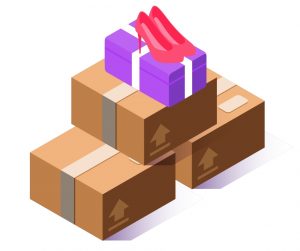Differences between Goods and Services: From time immemorial, there has always been a clean distinction between goods and services. Goods are objects or products that have been manufactured or produced, stored and transported to the place of delivery, marketed and sold. Eg: tomatoes, shoes, clothes, pens, watches, etc. Services on the other hand are the output of individuals and are equated with the performance that the consumers can see. Egs are the services of a doctor, a lawyer, a teacher, an accountant, a delivery service, etc.

In this article, there would be a complete distinction between goods and services, as even though they are pronounced together, they are in fact different and serve their different purposes for the consumer. The differences between goods and services are listed below.
Recommended: Major Tools for Economic Analysis
1. Goods are material and can be seen and touched while services are immaterial or intangible and cannot be seen and touched: Goods are material, can be seen touched and felt, and are ready for sale to the customers. Eg of goods are bread, bottle, belt, shoes. Services are intangible facilities that can be used to satisfy humans. It’s mostly in the form of help, effort or knowledge passed from one person to the other. For example: the service of a Doctor to a patient, the service of a lawyer to a client and the service of a teacher to a student.

Also see: How to prepare an examination in one week
2. Time is the most important factor in services: Time is of the essence in services, and delays are despised by the consumers. This is because inventories are absent in services and because production and consumption happens at the same time.

There should be little or no delay in providing the service or else it would lose its inherent value. Eg: The doctor should provide the service of care as at when due in order to help the sick patient get back on his feet, the lawyer should provide the client with the necessary advocacy, litigation or signing service, the cab should be on time, the plane on time and the food on time, if not customers would complain.
Time is not really of the essence with goods, because most times they are already in place for the consumer to come and choose what they want. Consumers looking for goods are more worried about the quality of the goods than the time it took them to get it, as most times they don’t even take any time at all.
The exception here is when there is a delivery of the goods to the consumer. When there is a delivery, the need to satisfy the consumers hunger for goods and services comes together, as the delivery is the service and the good should be up to the specification they asked for. Here the consumer worries about both the time(which is the delivery of the goods) and the quality of the goods (which is the perceived value of the goods).
Recommended: How to become a successful business entrepreneur
3. In purchasing goods, ownership is transferred, but when purchasing services, ownership isn’t transferred: ownership is the title an individual has to call something his. When you purchase a service, you cannot completely call it yours.

For instance, the service of a receptionist cannot be transferred, in that, even after she renders the service to you the user of the service, she still retains the ability, right or ownership of that service and is able to render it to another person.
In the case of goods, however, the person selling transfers the goods to the new owner, and the new owner retains the ability to keep or transfer the goods to another person because the goods becomes his own. The seller of the goods cannot retain the ability and right to own the goods any longer because he doesn’t have title any longer.
Also see: Advantages and Disadvantages of being a teacher
4. Goods can be returned while services cannot be returned: Goods are tangible items so you can be able to return them or exchange them, depending on the policies of the business you’ve purchased from.

You cannot return services you’ve purchased. Once the service provider provides the service, it’s not something that can be taken back. The service remains permanently with the person that has received it.
If you are dissatisfied with the service then the service provider corrects a defect that occured when providing the service, rarely is there a refund policy when providing a service. Even if there is a refund, it can be processed only based on the time the provider spent performing the service, for eg per hourly bases.
Also see: Differences between developing and developed countries
5. There is presence of inventory in the case of goods, while in the case of services there isn’t any inventory: Companies and individuals that provide goods have an inventory where this products are stored. This is to easily fill customers orders. A company that produces toothpase would produce enough that would last for weeks, if not months, and would distribute it to the retailers to distribute to the consumers.
Service based businesses don’t have an inventory where they store goods. Instead when a consumer wants a service, the service is provided via one of the service providers. For eg: a hospital that has doctors and nurses working in it provides healthbased services and this service is provided by the doctors and nurses and not goods that have been stored in an inventory.
Also see: Differences Between College and University
6. The lifespan of a good can be measured based on whether it is perishable or not, while a service doesn’t have a lifespan and cannot be measured: Goods are divided into perishable and non perishable goods, and perishable goods can easily spoil while non perishable goods take a longer time to spoil, eg beans, maize, rice, dried fish & meat. Even though perishable goods can be stored using cold storage processes, like putting fresh food in the freezer, in the refrigerator or in an open environment, this process doesn’t entirely prevent it from spoiling but only slows it down.
While a service is produced and exhusted at the same time. A service exists only at the moment when the person is engaged in the service, when the engagement ceases the service has been exhausted and can only continue if the distribution is to start all over again.
Recommended: Countries with the Highest Job opportunities
7. The quality of goods can be sustained, while the quality of a service varies: When manufacturing products, manufacturers try to maintain uniformity, and this is usually done through mass manufacturing. Uniformity is what every manufacturer strives for. This makes the quality to remain the same in all the products being manufactured, except if there is a minor mistake that ruins the uniformity that was initially planned.
Where as in the case of services, the quality of service may vary from time to time based on the strength, mental capacity, time and various other factors that affect the service provider. The service of a lawyer or doctor varies based on the particular person providing the service.
Recommended: Differences between Schooling and education
From the foregoing we have noticed that the clear difference between goods and services is tangablility, this means that goods can be touched while services can’t be touched, goods can be equated while services cannot be equated, and goods can be transferred from one person to another while services cannot be transferred, but in essence, the purpose of both goods and services is to provide satisfaction to a consumer, and this is what the producers seek to achieve.

Edeh Samuel Chukwuemeka, ACMC, is a lawyer and a certified mediator/conciliator in Nigeria. He is also a developer with knowledge in various programming languages. Samuel is determined to leverage his skills in technology, SEO, and legal practice to revolutionize the legal profession worldwide by creating web and mobile applications that simplify legal research. Sam is also passionate about educating and providing valuable information to people.